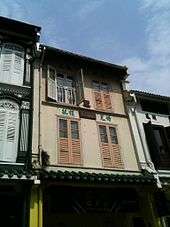Amoy Street, Singapore
Amoy Street (simplified Chinese: 厦门街; traditional Chinese: 廈門街) is a one-way street located within Chinatown, within the Outram district in Singapore.
| Namesake | Xiamen |
|---|---|
| Nearest metro station | Telok Ayer MRT station |
| Coordinates | 1.2814156°N 103.8473785°E |
Amoy Street starts at its junction with Telok Ayer Street and McCallum Street and ends with its junction with Pekin Street, now a pedestrian mall. It is intersected by Boon Tat Street and Cross Street.
Etymology and history
The name Amoy is an English transliteration of the Zhangzhou pronunciation of the words 厦门 (pronounced E-mui in Standard Hokkien (Amoy) and Xiamen in Standard Mandarin.) The Zhangzhou Hokkien pronunciation was used instead of Standard Xiamen Hokkien because of the overwhelming numbers of Zhangzhou people who left Amoy in China to settle in Singapore through the city's port. Amoy Street is one of the old streets developed during the 1830s defining Chinatown under Stamford Raffles' 1822 Plan. It was listed in George Drumgoole Coleman's 1836 Map of Singapore as "Amoi Street", which was probably a reference to the many migrants who came from Amoy.

During the British colonial era, Amoy Street was noted for its opium smoking dens. The Chinese name for the street is based on landmarks in the area: it is called ma cho keng au (妈祖宫后) in Hokkien (rear of the Ma Cho Temple), or kun yam miu hau kai in Cantonese (behind the Kun Yam temple), referring to the Thian Hock Keng Temple on Telok Ayer Street where both goddesses were worshipped.
Amoy Street was also known as ha mun kai in Cantonese, ha mun being the Cantonese pronunciation of the characters representing the name of the place Amoy.
The street was also known colloquially as Free School Street or ghi oh khau (义学口 front of the school) because the Cui Ying School was built here in 1854. It was in one of the shophouses here (Number 70) that the first Anglo-Chinese School was started on 1 March 1886. The shophouse has since been marked as a historic site.
No.22 Amoy Street Shophouse
No. 22 Amoy Street shophouse, situated in the north-eastern edge of Chinatown that fringes the Central Business district of Singapore, is a Late Shophouse style. It has elements of western classical architecture and influences of the neoclassical jalousie windows of Europe, which can be seen on its facade: rhythm of three vertical bays with distinguished horizontal bands in the form of centrally paired door height window shutters; the Georgian-style fanlights, the Classical Roman Doric moldings, the use of Classical proportions and orders, Doric piers and Corinthian pilasters. On top of that, there is a mixture of Chinese and Western decoratives too. The shophouse also has elements of vernacular architecture with the jack roof, veranda, and louvred windows.
Siang Cho Keng Temple - No.66 Amoy Street
Siang Cho Keong (仙祖宫) was built in 1869 and was originally named as Zhi Yun Miao (紫云庙). It was founded by Ven. Zheng Ming who brought the statue of Lu Fu Xian Zhu (呂府仙祖) from China. The temple was built in the Hokkien style, where the ends of the curved roof ridge sweeps outwards like swallow tails and the clay roof tiles are not glazed. Its foundation plaque indicated that the temple was located on current site because of its good feng shui (geomancy) location as the temple used to be facing the sea (before land reclamation) and Ann Siang Hill is at the back of the temple.[1]
References
- Victor R Savage, Brenda S A Yeoh (2004), Toponymics - A Study of Singapore Street Names, Eastern University Press, ISBN 981-210-364-3